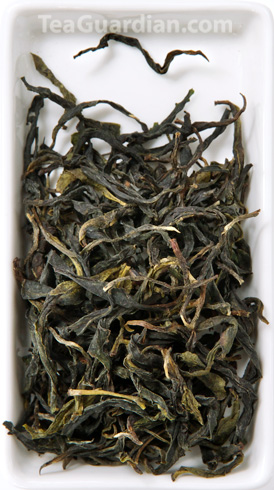Shiguping Wulong
Shi-gu-ping ( Chinese: 石古坪, 又作石鼓坪, 另有考為石牯坪, 無定案 ) is the name of a village in the Phoenix (Fenghuang) region of Chao-an county in north-east Guangdong, China. It is known only amongst a small number of tea aficionados for its oolong produced not from the Shuixian group of cultivars, but from a indigenous wulong cultivar so old and unique that it may be the oldest living and producing strand of predecessor to the Minnan (note) and Taiwanese groups.
a different cultivar
The dominant cultivars used for both Wuyi and Phoenix oolongs are of the Shuixian ( Chinese Narcissus ) family of cultivars, be it the famous Da Hongpao or restaurant grade Shuixian, or the tea connoisseurs’ well-liked great varieties of Fenghuang Dancongs ( Chinese: 鳳凰單欉, generally known as Phoenix oolongs ). Shuixian produced oolongs, as reasonably associated with the name, are more bouquet ( when the quality is right ) and yet unavoidably slightly bitter and astringent, albeit to many tea lovers’ liking, including myself. Oolongs produced from the wulong family of cultivars are less bitter and astringent, more creamy in texture and sometimes even in taste, yet the bouquet fragrance not as floral nor prominent. Some people like that.
So we hunted out this tea — Shiguping Wulong ( 石古坪烏龍 )
Instead of going north from the town of Phoenix towards Wudong, half an hour to the east up mountain is Shiguping, a remote village which fortune has not flourished with its tea as has been the rest of Phoenix. Further up the dirt road for about half a kilometre is Liaocuoya ( Chinese: 寮厝埡 ) the birthplace of the legendary oolong.
more “fermented” than greener oolongs
Unlike most of Taiwan or Minnan origins, the wulong of Shiguping is a lot more oxidized. There is less vegetative taste to it. The aroma is more “ripe” with accents of honey and fruits. The taste is comparatively fuller, more complex.
I read sometime ago in some of China’s numerous tea blogs that the leaves of Shiguping wulong are thinner than those of Shuixian. As in Chinese blogs of any other categories, once there is a saying, it got copied or parroted hundreds of times by writers or web masters who feel that they are too smart to write anything original, or even really study anything. So the saying have rapidly become reality by repetition, as far as the virtual world goes.

Left to right: Milan Xiang Dancong, Shiguping Wulong, Wenshan Paochong
Notice the thinner and more oxidized leaves of Milan, the thick leathery leaves of Shipping and the least oxidized leaves of the Paochong
thicker leaves — more work in processing
Leaves of Shiguping wulong are, in the real world, thicker than most Fenghuang Shuixian cultivars. That is why they can withstand the very traditional approach of many rounds of shaking and bruising — yao qing ( Chinese: 搖青 ) during the oxidation process.
This more complex process gives the tea its longer and fuller body. I am not sure whether they can do the same in Taiwan or Anxi with the thicker leaves of some of the cultivars, but I am sure they can do it at least one or two rounds longer than they do for certain harvests to yield better body in taste. Interestingly, through my career in tea, I have only seen oxidation becoming shorter in those areas.
shiguping wulong vs fenghuang dancong vs wenshan paochong
If I have to compare Shiguping with a Fenghuang Dancong and a Wenshan, I would say the Dancong is more sweet in aroma, the Wenshan and the Shiguping creamier, and the Shiguping relatively sweeter. In terms of taste, the Dancong is by far the most complex, the Shiguping the roundest and the Wenshan the smoothest.
- Infused leaves: Milan Xiang Dancong Comparing the infused leaves of: Shiguping oolong, Fenghuang Dancong, and Wenshan Paochong
- Infused leaves: Shiguping Wulong 石古坪烏龍 Comparing the infused leaves of: Shiguping Wulong, Fenghuang Dancong, and Wenshan Paochong
- Infused leaves: Wenshan Paochong 文山包種 Comparing the infused leaves of: Shiguping oolong, Fenghuang Dancong, and Wenshan Paochong
Read the captions to the photos to find out more about the comparative qualities.
traditional quality shows its true light
People who produce this oolong have made a distinctive choice: respecting the tradition in quality rather than following trend to reduce oxidation and baking for the extra floral aroma and fresh green taste to please less seasoned tea drinkers.
This means more work and cost for the farmer. Since their production is minuscule even amongst Phoenix oolongs, the opportunity cost for producing a product for a shrinking population who can appreciate this tea is high. Yet because less people know this tea, the farmers can never ask for prices like their peers do in Wudong. That is why less than a handful people are still producing this wulong.
a fine tea
Shiguping wulong is a rare and delicate, round-bodied and very fine oolong from the Phoenix region. It is a great alternative to the dazzling beauty of dancongs. To an old tea tongue like myself, it is a great change of pace and yet with its subtle complexity and long-lasting clean aftertaste, even the very snobbish taste buds of mine can’t complain.
















Some oolong varieties are indeed mature-able while others not. Shiguping is not mature-able unless re-baked for the process. Personally, I think it is a better tea when fresh than matured. On the other hand, classic dancongs are better when matured than fresh. Kept well, classic dancongs can mature for quite many years. It is specific selections that are different in terms of how many year. Bouquet dancongs generally are also better when fresher. They can be matured after they are properly re-baked. All properly processed dancongs keep well for many years.
Is this tea maturable. I am still confused with what oolongs are maturable, or not. Does it have to do to oxidation, or the baking. do dancongs only need a few years of maturing before the taste deteriorates?